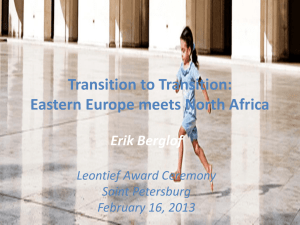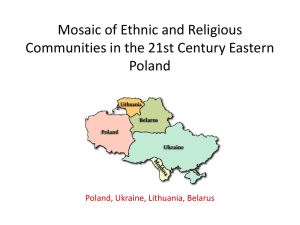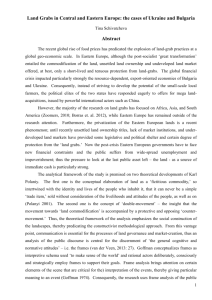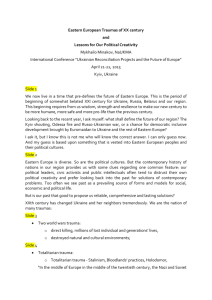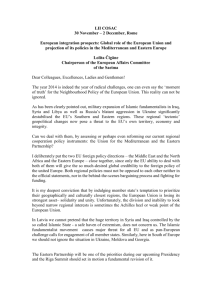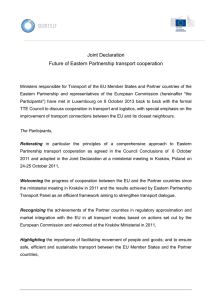Transition to Transition: Emerging Europe meets North Africa
advertisement
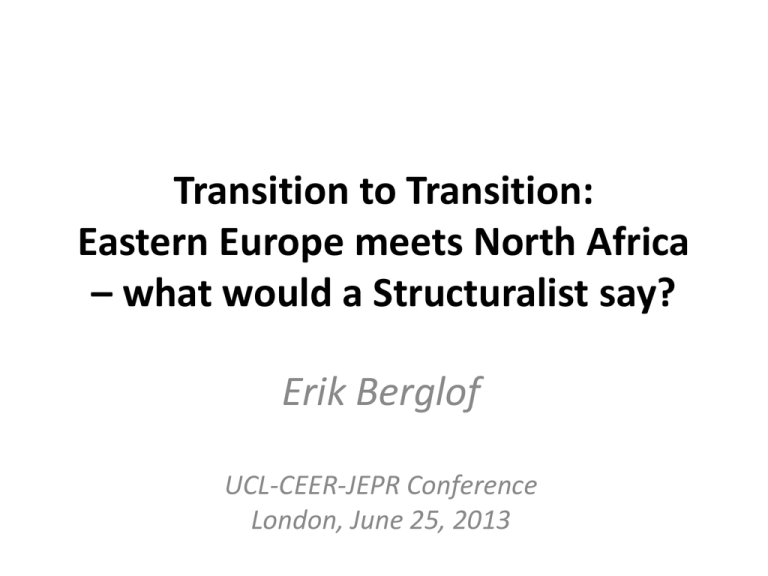
Transition to Transition: Eastern Europe meets North Africa – what would a Structuralist say? Erik Berglof UCL-CEER-JEPR Conference London, June 25, 2013 Sharing of development experiences • Advanced economies imposed their experiences for centuries - with brute force or through “soft power” • Central European countries actively promoted their own experience; “soft power”, but no hidden agenda • Russia expanded its development assistance; soft power in circumference, but little beyond • What can North Africa learn from Eastern Europe – what can Eastern Europe learn from North Africa? We are all Structuralists now • Why so little convergence in 20th century? – Global trading system rigged against LDCs • Why so few countries gone from middle income to high income status? (Eichengreen et al., 2012) – Some even regressed – a few more in the crisis • Seeking answers in ”market failures” – Structural rigidities – broadly accepted – Interventionist policies – question how to intervene • Specifically attacked the Washington Consensus – Copying institutions rather than industries Is Eastern European transition a challenge to structuralism? • A large group of countries, mainly in Central Europe, have successfully converged • More or less all countries have eliminated the ”TFP gap” (relative to GDP per capita) • Done so by copying institutions (and attracting investment), rather than copying industries • To a considerable extent they have followed the (modified) Washington Consensus Outline 1. 2. 3. 4. 5. What are the transition outcomes to date? What have we learned about transition? Can North Africa learn from Eastern Europe? Can Eastern Europe learn from North Africa? What would a Structuralist say? Successful transition led to convergence • Many reform trajectories... – differed in almost every conceivable aspect of reform (privatisation method, bank restructuring, equity markets, foreign bank entry...) • ...but convergence towards one model – ”emerging market form of capitalism” (concentrated ownership by owner-entrepreneur, bank-dominated, weak capital markets...) Institutional deficit – the catch-up premium Institutional ”catch-up” complete? Similar trajectories within groups of countries Many stuck in economic transition Economic transition linked to political transition, but variance considerable © European Bank for Reconstruction and Development 2010 | www.ebrd.com 11 2. What have we learned about transition? European transition experience: (Shleifer, 2012) 1. 2. 3. 4. Dramatic output drop in first years of transition Recovery and rapid growth nearly everywhere Decline in output did not lead to populist revolts Economists and policymakers overstated their ability to sequence reforms and importance of particular strategic choices (e.g., privatisations) 5. Exaggerated benefits of incentives on their own – changes in people also necessary Transition – a learning process • Conceptual understanding improved – Initial linear notion of reform – turned out differently – Institutions required for markets to function – Private sector driver, but state needed as support – Political economy of reform – threat of reversal • Availability of data better • Plenty of experience – shaped perceptions: ”privatisation” and ”liberalisation”, but also ”democracy” have a context and connotation History shapes transition perceptions • Pre-communist patterns influence transition process – eastern European backwardness (Berend, 2003) – experience of rule of law in Central Europe – Pale of settlement (Grosfeld, Rodnyansky and Zhuravskaya, 2013) – Habsburg empire (Grosjean, 2012a; Baecker et al. (2012) – World War II (Grosjean, 2012b; Grosfeld and Zhuravskaya, 2013) • Differences among communist systems – Soviet Union vs. rest, former Yugoslavia, within SU differences (Baltic states vs. other republics) • Conflicts during transition – affect political trust and legitimacy, and slow to change afterwards (Tajik civil war (Grosjean, 2012c)); former Yugoslavia (LITS, 2006)) View of institutional change evolved • Culture, geography and institutions – the primacy of institutions (Acemoglu, Johnson and Robinson, 2001, 2002) • Extractive-productive economic institution, exclusiveinclusive political institutions (Acemoglu and Robinson, 2012) • Human capital endowment – interactions with institutional quality (Shleifer, 2012) • Schumpetarian growth – distance to technological frontier (Aghion et al., 2013) • Institutions with a small ”i” – institutions not destiny; development objects can be achieved even when institutions weak (Banerjee and Duflo, 2011) What explains success? • Initial conditions – proximity to Europe – recent experience of rule of law – strength of Soviet legacy • Outside anchor of EU accession – overcome status quo bias and individual veto players – the larger the prize, the more certain, the closer in time (Berglof and Roland, 2000) – weaker once inside, but clubs-in-clubs (e.g., the Eurozone within the EU) can help sustain reform momentum (Berglof et al., 2010 and 2013) Many ways of getting stuck • Non-reformers – old guard hanging on (Turkmenistan, Belarus, Uzbekistan) • ”Failed” states (Tadjikistan, Kyrgyz Republic) • Initial winners of reform captured process (Ukraine) • Resource trap (Azerbaijan, Kazakhstan) • Middle-income trap? (Tunisia, Egypt, Russia?) • All lack meaningful anchors, or... Ukraine? In danger of getting trapped? 3. What can North Africa learn from Eastern Europe Transferring transition experience treacherous, but suggestive... • Politically, some (superficial) similarities between Egypt today and central and eastern Europe in early 1990s • Economically, Egypt 2013 is more like Ukraine and Romania 2013 than Poland in 1989 or Ukraine in 1991 • ...but deep differences in demographics and distribution • ...and in history and culture “Transition gaps”: traditional EBRD region and southern Mediterranean countries SEMED region comparable to Caucasus countries, Kazakhstan, and Ukraine. Note: Countries classified according to average of 16 sector transition indicator scores in 2012. Mid-transition - implications • Should not suffer deep transitional recession – uncertainty affects investment, but no collapse • Should escape wide-spread unhappiness due to output shock and shock to human capital • But strong post-recession rebound also unlikely – low-hanging fruit already picked • Key reforms like ”privatisation” and ”liberalisation” loaded by decades of experience 5. Conclusions Revisting Structuralism I • History important part of initial conditions – shaped perceptions • Extraordinary variety in specific policies, but nevertheless remarkable convergence • Have adopted ”emerging market institutions”, rather than advanced market institutions (at least in some respects) • Many transition countries, outside Central Europe, are stuck in transition (structural impediments – political economy) Revisting Structuralism II • Successful countries adopted institutions fit for growth at some distance from the frontier, but next phase more difficult • Countries are stuck in transition for many different reasons – most of them structural, but how to differentiate? • A few countries (Russia, Kazakhstan...) increasingly tried interventionist policies – with mixed results • How to think of ”outside anchors” as a Structuralist? Extra slides Modern growth theory • Endogenous growth – Technology, human capital, political institutions, demographic variables, openness to trade and finance, geography, natural resource rents at least in part endogenous • ”Schumpetarian” – creative destruction – – – – Intense competition, openness, research education Stronger effect closer to the technological frontier Interact policy with technological development Interact with other policy variables or institutions • Appropriate institutions – distance to frontier How to think about democracy, markets and growth • More demands for redistribution when median voter is poor (Persson and Tabellini, 1994) • Growth theory: reduces the scope for expropriation or preventing entry – reduces creative destruction • Growth is higher in more democratic countries when closer to the frontier (Aghion et al., 2007) • Democracy matters more for frontier innovations (Aghion et al., 2013)

